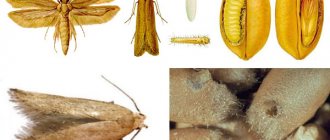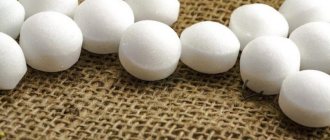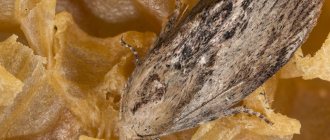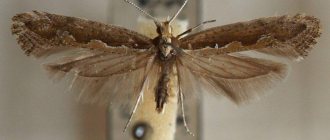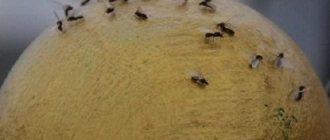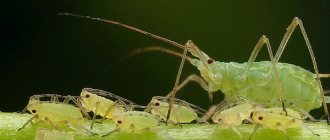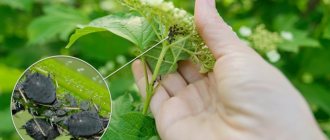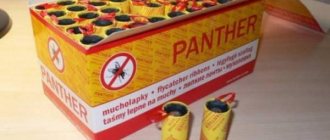Moths are among the harmful insects that are the most unwanted guests in our home. These small pests cause us not only inconvenience and discomfort, but also serious damage in the form of spoiled expensive fur coats, dresses made from natural fabrics and food. Moths include clothing, fur, furniture, kitchen and grain moths.
This insect especially often settles in polluted places. Therefore, to prevent its occurrence, you should carefully monitor the cleanliness of the room. If moths have already appeared in your home, then it is necessary to take urgent measures to combat it.
Features of using folk remedies for moths in an apartment
All known methods of getting rid of pests differ depending on what type of moth you have to fight: clothes moths or kitchen moths.
But they all have the same quality: they simply repel insects without destroying them . The only drawback of all these methods is their slow action.
Next, we’ll tell you in more detail about how to get rid of moths in an apartment using folk remedies?
What plants produce phytoncides?
Some of the most reliable plant protectors of the garden include basil, onion, mustard, mint, lemon balm and dandelion.
Basil.
The phytoncides contained in this plant repel insect pests such as five-spotted hawkmoth, aphids, and many others. Planting this plant next to beans will reduce bean weevil damage.
Mustard.
Mustard powder is usually used against red apple mites, aphids, sawflies, cutworm caterpillars, whites and other pests. However, you can prepare a decoction from the above-ground parts of plants. Infuse 100 g of finely chopped raw materials in 1 liter of water in a tightly closed container for 1 day. Add 8 liters of water and boil for 30 minutes. Cool and filter.
Onion.
Used in the fight against bedbugs, aphids, copperheads, spider mites, and codling moths. For this purpose, an infusion of onion peels is used, which is sprayed on plants. Planting onions around the perimeter of the area where strawberries are grown gives good results. This will help repel the strawberry weevil.
Melissa.
This phytoncidal plant is used in the fight against aphids. Since it repels ants, which are carried by aphids, it is a good idea to plant lemon balm near your vegetable crops. In addition, for the same purpose, lemon balm infusion is used, which is sprayed on plants.
Mint.
Repels flea beetles, whiteflies, ants, cabbage whites, and caterpillars. In addition, peppermint attracts entomophagous insects, such as predatory wasps and hover flies, which destroy aphids.
Next, you will find out what other plants produce phytoncides.
Orange peels
Orange peels, as well as lemon and tangerine peels, are an old folk method of getting rid of moths. Their strong odor frightens adult butterflies .
Where the crusts are laid out: in cabinets or nightstands, they do not lay eggs. This is good for preventive purposes or to repel insects.
Rules of application:
- Place fresh citrus fruit peels near food products.
- Peels that dry out and lose their flavor must be replaced promptly.
Spray use
The principle of action is the same as that of an aerosol - enteric contact. Contains larger insecticide particles that do not float in the air, but immediately settle on the surface. Therefore, moth spray is less toxic to humans and pets than an aerosol. Before spraying the substance, you do not need to wear a respiratory mask, goggles and gloves.
How to use the product?
- Shake the spray bottle for 2-3 seconds.
- At a distance of 20-25 centimeters from clothing (shoes, interior shelves or closet walls), press the spray head. For treating a surface area of 1 sq. The meter requires 50-60 clicks.
- After a day, put your clothes in the washing machine and clean your shoes. Do not wipe the interior surfaces of the cabinet.
The procedure is repeated every 6 months for preventive purposes.
Laundry soap
Another popular, but most importantly universal method , the main disadvantage of which is the unpleasant odor characteristic of soap.
Few people will wear expensive and beautiful clothes if they smell of laundry soap.
But laundry soap repels adult individuals and very noticeably limits the movement of caterpillars . This product is affordable to any buyer. It is especially convenient to use it to get rid of insects that have settled in pantries and closets.
For quality use, place pieces of fresh laundry soap inside kitchen furniture or place them in the pockets of clothing that needs to be protected.
Lavender for moths
Lavender is considered the most popular folk remedy. This plant has a strong and very pleasant smell. It doesn't run out of steam for a long time. Lavender effectively repels both caterpillars and adult butterflies .
At the same time, dried flowers and essential oil made from the plant , which is a component of many industrial products used to get rid of insect pests, are equally effective.
Place the leaves of the plant in porous bags around the apartment, place them in the wardrobe between stacked things . If we are talking about essential oil, then it is placed on the shelves of cabinets directly in open vessels.
Clothes can be protected by spraying them with lavender infusion . You just have to do this often.
Important! Do not spray lavender or any other essential liquid onto your clothing. The quality of this product varies. If it contains at least a little palm or sunflower oil, stains will remain on things that are difficult or even impossible to remove.
Let's recognize the enemy by sight
The moth family is rich in species that coexist with humans, animals that thrive in caves inhabited by bats, and bird nests. There are about 3000 species in total, but only 4 of them annoy humans:
- wardrobe;
- food (fruit, flour moths, preferring grains, various types of moths);
- carpet;
- fur moth.
These insects feed on mold fungi, animal debris that contains keratin (combed wool, feathers and fluff residue), dried mushrooms and grain crops. The moth is considered an almost omnivorous insect, capable of eating even snake venom in dry form without harm.
Plant repellents do not harm the health of the butterfly, but only repel it with their aroma, which for some reason is unpleasant for the moth. The olfactory elements of the moth are much more sensitive than the human nose. It is believed that moths are 2 orders of magnitude superior to humans in their ability to recognize odors. And it can be driven away from a shelf with cereals or from a closet with clothes by a strong, pungent smell for the moth’s sense of smell.
Those moths that people chase around the apartment are usually males. Females prefer not to show themselves to the two-legged inhabitants of apartment “caves”; they crawl from thing to thing and hide in its folds. In its development, a moth, like any butterfly, goes through several stages: eggs, larvae, pupae, imago (adult stage).
Adults do not pose a danger to cereal supplies or the fur coat of the apartment owner. The butterfly's mouthparts are reduced and are not capable of damaging a single thing. Those “traces of a crime” that a person can find in a bag of porridge or holes in a woolen sweater belong to the developed apparatus of the butterfly larva. It can even chew through plastic that protects things or cereals.
Mint
Like lavender, this plant has a strong scent .
It is used in a similar way: the dried leaves are laid out in small bags and placed where there should be a large concentration of pests.
From time to time it is recommended to check whether the pouch is exhausted. If this happens, replace it with another one with fresher dried leaves. To increase efficiency, you can place them in the wardrobe in the pockets of sweaters, coats, fur coats and jackets .
Recommended plants
Using plants to control pests is one of the safest methods. Moreover, for a person the aromas of herbs will be, on the contrary, pleasant, but for a parasite they will be disgusting.
Sagebrush
This means of killing and repelling moths is used very often. It is not difficult to find; it grows in ravines and forest clearings. The stems and flowers of wormwood should be collected in July and dried in the shade. The dried plant is placed in fabric bags and placed in cabinets. In addition to moths, the aroma of wormwood also works against flies, ants, fleas and cockroaches. In addition to placing dead wood in cabinets, you can wash your living space (floors, furniture) with a decoction of this herb.
Geranium
This indoor plant grows on the window of many residents of our country. When in contact with the leaves and stems of geranium, the aroma intensifies, so intolerable by moths.
To repel insects, place fresh leaves in closets and bedside tables with clothes and keep them there until dry. After this, they need to be replaced with new ones.
You can also use geranium essential oil: 20-25 drops of essential oil per 1 liter. water. Wash the apartment with this solution. With the aroma created, the pest will not be able to live and will certainly not settle in such a home. If, nevertheless, the insect has already settled, geranium can significantly reduce the number of uninvited guests or “evict” them completely.
Lavender
This plant cannot be collected in every region, but you can buy dried flowers and leaves at almost any pharmacy. Moths are terribly afraid of the smell of lavender, and if you place self-made rag bags (sachets) with a dried plant in the cabinets, the insect will definitely not get in.
Ledum
The plant is poisonous, so it is better not to abuse this remedy. If its aroma is too strong, unpleasant consequences will affect a person: nausea or headache will be guaranteed. In small quantities, wild rosemary will not cause harm, but the moth will still feel it and try to retreat.
Rosemary
The principle of using rosemary is the same: leaves laid out on furniture shelves. However, its smell is not so persistent, so it will require frequent updating. The smell of this plant is specific; the flying pest cannot stand it. It is also possible to use its oil.
You can grow rosemary at home in pots. In this case, the moth repeller will always be available; you only need to replace the “exhausted” leaves with new ones as needed.
Lemon mint
Disgusting to moths, but very pleasant to humans, the aroma of mint will not only help get rid of the parasite, but will also calm you down and create an aura of comfort in your home.
Moth butterflies, so sensitive to odors, will never risk settling in a house that smells of mint.
Tansy
Tansy, also popularly called “wild mountain ash,” grows everywhere, and it is not difficult to get it. As a last resort, buying it at the pharmacy (herbal preparations with it are also suitable) is even easier. A medicinal plant, which at the same time can be poisonous to humans in inappropriate doses, is very good at repelling moths with its smell.
The dried plant must be placed in areas where moths are most likely to gather, after which the insect will have to say goodbye to its “habitable” place.
Immortelle
Immortelle baskets can be stored in dried form for years, emitting a pungent aroma that is intolerable to moths. An insect will definitely not risk settling in a home if it smells this plant.
Thyme (thyme)
Prepare fabric cases or gauze pads, fill them with dried thyme and place them on each shelf where clothes attractive to moths are located (fur, wool, etc.). Things will acquire a very pleasant smell, and the moth, which cannot stand it, will hastily leave the room and will not want to return there again.
You should not constantly use the same plants or oils, as their aromas can gradually become addictive to the moth. It is better to periodically change the herbs, then parasites will not be able to settle in the home.
Geranium
The fight against small gray butterflies that have settled in the house is not always active and involves the use of means specially prepared for this. There are also passive ways. Often it is enough to place an indoor flower on the windowsill, like an ordinary geranium .
Many insects cannot tolerate the smell of this plant. If the apartment is large, get several bushes. Place one pot in each room. Geranium is equally effective against both kitchen and clothes moths.
Always keep live flower bushes in your apartment. Periodically open kitchen cabinets, wardrobes and bedside tables, ventilating them once every few days.
Rosemary
Rosemary repels mosquitoes and other insects that are harmful to plants. Rosemary is available today in various forms. The plants can be grown in pots on the patio and shaped into ornamental bushes in the garden (some varieties can grow quite large). Rosemary is also wonderful in cooking. The plant and its cuttings themselves are effective repellents.
You can make a simple repellent spray: boil 500 grams of dried rosemary in a liter of water for 20 to 30 minutes. Then cool and pour into a container with a dispenser. The solution must be stored in the refrigerator!
Other herbs:
- Bay leaf: repels flies. Dried bay leaves, which are sold in stores for adding to soups and stir-fries, are not suitable. Therefore, grow bay leaves at home.
- Onion: repels flies, Japanese beetles (aka Japanese beetles) and aphids.
- Dill: against aphids, edgeworms, spider mites, cutworms, cabbage and hawk moths.
- Fennel: Helps control aphids, slugs and snails.
- Melissa officinalis: repels mosquitoes.
- Oregano: repels many pests and adds moisture to the soil.
- Parsley: repels various bugs.
- Thyme: repels whiteflies, armyworms, etc.
horse chestnut
It turns out that chestnut protects well from insect pests. Its seeds should be collected in late autumn.
After drying them in the oven (raw chestnuts quickly become moldy), place them on shelves in the cupboards. You won't need bags here.
Chestnut has several advantages:
- The fruits are easy to collect and just as easy to arrange;
- They act effectively and do not have a strong aroma ;
- The fruits are quite large in size, so they are not capable of littering the apartment.
Chrysanthemums
The ingredient in chrysanthemums that makes them such an effective insect repellent is pyrethrum. Chrysanthemums repel ants, Japanese beetles, ticks, lice, fleas, bedbugs, spider mites, beetles, etc.
Pyrethrums in chrysanthemums can kill flying and jumping insects, are used in the most common American home and garden insecticide, and are often used in room sprays, homemade shampoos and aerosol bombs.
However, pyrethrum may be a human carcinogen and caution should be exercised. Make sure you are not at risk
Vinegar and garlic
Vinegar and garlic do not have a very pleasant smell. Although it is precisely because of it that they are considered a good means of fighting insects. It is better to store garlic in the kitchen, inside cabinets or in pantries next to other food products, and it is recommended to add vinegar to the water when cleaning the floor in the apartment.
The butterfly does not tolerate spicy plants, including thyme, rosemary and cloves. They can be placed in bags, combined with each other, or used each separately. Such sets are distributed throughout the apartment and repel pests from the premises for a long period.
What is he afraid of?
To understand what the kitchen moth is afraid of, you should determine its habitat. In the kitchen, the parasite can be found in cereals, flour, and any dry food products. To eliminate larvae, you should carefully review all packages of cereals, seasonings and similar substances.
It is important to get rid of all contaminated food items, otherwise others will gradually become affected.
Shelves can be treated with laundry soap or essential oils. This will be safe for the health of household members. Also, to repel, bunches of fragrant herbs such as mint and lavender are laid out. Spicy odors do not kill parasites, but only force them to look for another home.
Also, in the absence of lavender and mint, use bay leaf and garlic against kitchen moths.
But what you should be more afraid of is not flying individuals, but their larvae, which hide in secluded dark places and spoil food and things.
Fragrant tobacco
Tobacco is another effective folk method against gray butterflies. Fragrant tobacco is usually used as a houseplant, but as for smoking tobacco, it is better to use it in the form of small dry leaves, as in the cigarettes we are used to.
Place regular tobacco in bags and place inside pieces of furniture. Don't forget to ventilate your wardrobe periodically.
Attention! Do not use tobacco to protect clothing from moths. Things soaked in it will lose their attractiveness.
Popular questions
To understand at what temperature the moth dies, it is worth noting that apartment conditions are the most ideal for the parasite. Sharp jumps, both upward and downward, are dangerous for the insect. At +53°C, 10 minutes in the sun is enough; at +45°C, half an hour is needed.
If things need to be boiled, this will get rid of moths in a few minutes. At -5C it will take a day, and at -20°C half an hour will be enough. Much will depend on the density of the fabric.
What repels moths in the house cannot kill the larvae. And they are the ones to be afraid of. Adults do not spoil things because their oral and food apparatus are reduced.
It is important to know how to drive away an insect. They say that even if you put dried snake venom for moths, it will be safe
This once again confirms the omnivorous nature of the parasite.
Since moth larvae can even damage a plastic bag to get food, it is important to know what moths do not like. Strong aromas and temperature changes are unacceptable to the parasite.
That is why, with constant ventilation, daily cleaning and frequent drying of things in the sun, the winged insect rarely looks into the house.
The larvae are more resistant to aromas, but when things are shaken, they quickly leave their new home, since they do not have any attachment. The best method of dealing with masonry is thermal and mechanical surface treatment.
Scented herbs
Insects are repelled by bunches of wild or cultivated fragrant herbs. Among them, the most effective means are the following:
- Sagebrush;
- Tansy;
- Chamomile;
- Valerian;
- Marigold;
- Carnation.
Other folk methods and means to repel annoying pests:
- Camphor . Soak swabs in it and place them in places where butterflies accumulate.
- A combination of lemon and cloves . The buds of a spicy plant are stuck into half a lemon and suspended on a strong thread above the shelves with things.
- Pieces of cedar twigs and wood are also not carried by insects. Place them in wardrobes where fur coats hang. You can also use cedar needle oil for this purpose.
- black pepper (peas) using the same method .
- Residents claim that sometimes gray butterflies are repelled by the smell of fresh newspapers . But experts consider this method rather dubious.
Advice! To prevent insects from infesting the kitchen, the best solution would be to store cereals in closed containers or tightly tied bags. Before storage, clean outer clothing and put plastic covers on it.
Do not forget to regularly ventilate the apartment and constantly clean it using disinfectants. Moths are afraid of low and high temperatures. So washing in hot water, frying clothes in the open sun or airing in frosty air makes it possible to get rid of females, eggs of pests or their larvae.
By the way, the larvae and eggs are attached to clothes very weakly, so they fall to the floor at the slightest shaking. For this reason, items that are constantly worn are rarely damaged. Those who hang in wardrobes for a long time and wait in the wings suffer the most.
Newspapers
Moths cannot stand the smell of printing ink. Our grandmothers covered the shelves of cupboards and wardrobes with newspapers. To protect your favorite fur coat from damage, you can remember the old folk method and put several crumpled newspapers in a case with outerwear.
To achieve the greatest effect, the press must be fresh. When storing winter boots in your closet, stuff your boots and boots tightly with crumpled up newspaper. In this way, two problems are solved: the shoes retain their shape, and moths will never appear in them.
Essential oils
Essential liquids are an excellent and very effective folk remedy for repelling pests.
fir, eucalyptus, rosemary oil, as well as patchouli, lemongrass and citronella oil are actively used .
Mode of application:
- Rinse the floor with water, after adding a few drops of essential liquid;
- Wipe the shelves and surfaces where moths may accumulate with oil;
- Lay out the swabs soaked in liquid;
- Spray cabinets and rooms;
- Place open bottles of anti-pest oils in wardrobes, kitchen cabinets and bedside tables.
Larvae
These transitional insect organisms are the most important pests. Caterpillars eat a large amount of lint, which is why bald spots and holes are clearly visible on products. The larva has a white or yellowish color and is small in size. The head of the caterpillar has a brown tint, and small legs are located on the body. The body is adapted to active movement and eating surfaces. Usually there are no holes on fur products, but as the insect moves, a gnawed path remains. Moth larvae are easily transported from one place to another along with clothing, so moths can be brought in if old things were brought into the house from outside.
At the first sign of flying insects, it's a good idea to inspect your closets and carpets. All damaged items must be removed. Treatment for prevention is carried out several times a year.
Naphthalene
Perhaps the most famous and most effective folk remedy for moths is naphthalene.
IMPORTANT! today it is not recommended for residential buildings .
But mothballs are still popular and help get rid of butterflies and insect larvae that cannot stand its pungent smell. Bags of mothballs are usually placed between stacks of clothes on the shelves of wardrobes.
Naphthalene is not able to fight food moths (more about fighting kitchen moths), only clothes moths, since food actively absorbs odors. Therefore, it would be unwise to expose food to spoilage. But there are many modern substitutes for naphthalene against pests that are no less effective.
Modern chemical compounds, which are freely sold in specialized stores, are always ready to help folk remedies for moths in the house.
But you shouldn’t neglect your grandmother’s old methods either, which, as practice shows, do not lose their effectiveness over the years and can be used when really necessary.
So, we told you how to fight moths using folk remedies, described flowers and plants that repel the pest, and also gave advice on how to remove moths from the kitchen using folk remedies?
NOTE! Find out where moths come from in an apartment? Did you know that wax moth exists, and the tincture of its larvae has many medicinal properties.
Review of chemicals
As a rule, the use of chemical means of control is started when folk and available substances do not cope with their task. Chemicals have a great effect, but their use requires special protective equipment and a number of recommendations, as well as preparatory operations. The whole point is that at the time of processing the premises there should be no residents in it. Sometimes such conditions are simply impossible to meet. This is especially true when sick people who are unable to move independently live in the house. In addition, you need to find a roof over your head to wait until the chemistry wears off.
Special anti-moth sections
Such means of control are placed in closets, chests of drawers, etc., where these insects like to climb. There are types of plates that can be used even in the kitchen. These plates are valid for 6 months. They repel insects due to the unpleasant odor that these plates emit. As a rule, after some time the moth will completely disappear from the apartment.
The plates “Moskitol”, “Raid”, “Armol” and “Raptor” are produced. Manufacturers have thought about how to conveniently attach the plates anywhere. In this regard, this type of product is very popular.
Using moth traps
The traps are distinguished by the fact that they are absolutely safe for others, but have a detrimental effect on males, attracting them with a special aroma. Therefore, over time, the reproduction of insects decreases and, as a result, the moth disappears. This type of trap is safe for humans, since there are no harmful vapors or any ultrasound that affects the hearing organs. Such products include Mosquitall and Raptor traps.
Aerosols
Some chemicals are available in aerosol form. Like all other chemical components, aerosols have a detrimental effect on larvae and adults, but can also cause allergic reactions and have an unpleasant odor. They are also not always suitable for use in homes.
Rules of application:
- Do not spray the product anywhere. You should focus on areas where larvae and adults are concentrated.
- Aerosols are sprayed only when wearing personal protective equipment.
- Before spraying begins, all family members with pets must leave the apartment.
- You can return to your home only after the time specified in the instructions.
- Before returning, it is advisable to do a wet cleaning by wiping all surfaces with a soap and soda solution.
Recommendations for the use of aerosols:
- Aerosol "Raptor".
- Aerosol "Dichlorvos".
- Aerosol "Raid".
- Aerosol “Clean House”.
- Aerosol "Difox".
- Aerosol "Extra Mit".
Spray
Sprays are produced in plastic containers with spray nozzles. Some of the drugs have a high degree of toxicity. Such control agents effectively destroy insects and are also suitable as a prophylactic agent.
The product is sprayed onto knitted and fur items, including the surface of furniture. Often the moth dies after the first treatment.
Compositions available for use:
- ARGUS.
- Mosquitall.
- Tornado.

